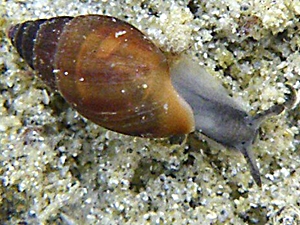
Mouse ear snail (Myosotella myosotis).
Picture: Florence Gully, Nature 22: Gastéropodes 2.
 Mouse ear snail (Myosotella myosotis). Picture: Florence Gully, Nature 22: Gastéropodes 2. |
Coast snails of the superfamily Ellobioidea are pulmonate snails, but contrary to terrestrial pulmonate snails, they have maintained an earlier state in evolution, as it may have been when the first snails had settled on dry land. Since the first snails had managed to achieve this transgression, a similar evolution has taken place several times in different systematic snail groups. The transgression from the sea to dry land did not exclusively take place directly, but also by the detour through fresh water.
Coast snails with their short conical shells mostly are still inhabitants of the littoral zones at the coasts, like for example the mouse ear snail (Myosotella myosotis). Even if their eyes are still placed at the tentacles base, those snails are not water pulmonates (Basommatophora) like pond snails (Lymnaeidae), but more closely related to terrestrial pulmonate snails (Stylommatophora). For that reason, they have been placed in an order on their own (Actophila), opposed to the both orders already mentioned. verwandt.
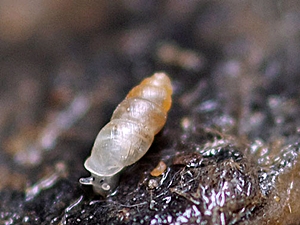 Slender thorn snail (Carychium tridentatum) from the canton St. Gallen in Switzerland. Picture: © Stefan Haller. |
| Nordsieck, H. (1993a): Phylogeny and system of the Pulmonata (Gastropoda). - Arch. Moll. 121 (1/6): 31 - 52. |
Apart from the nearly marine species from the Ellobiidae family, like the mouse ear snail (Myosotella myosotis) and the two tooth mouse ear snail (Auriculinella bidentata), in Europe the superfamily only contains one single group of exclusively terrestrial snails, the family of thorn snails (Carychiidae).
Class: Gastropoda
![]() Subclass: Pulmonata
Subclass: Pulmonata
![]() Superorder: Eupulmonata
Superorder: Eupulmonata
![]() Order: Actophila
Order: Actophila
![]() Superfamily: Ellobioidea
Superfamily: Ellobioidea
![]() Family: Ellobiidae
Family: Ellobiidae
![]() Family: Carychiidae
Family: Carychiidae
Mouse Ear Snail - Myosotella myosotis (Draparnaud 1801)
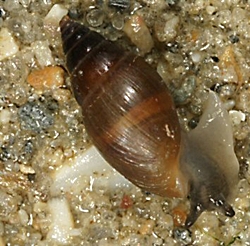 Mouse ear snail (Myosotella myosotis). Picture: Marc Cochu, Nature 22: Gastéropodes 2. |
Description: The mouse ear snail has got a brownish yellow shell with a glossy appearance. Under a strong magnification, it becomes apparent that the upper whorls are slightly striated and sometimes even show hairs. The shell mouth is pointedly oval with a whitish lip. On the upper (parietal) side there often is a whitish layer (callus). The upper (parietal) lamella (1) is distinctly built und running horizontally. Often, there is even a second parietal lamella. The lower (columellar) lamella (2) on the shell spindle is also quite distinctly built. The shell navel (umbilicus) usually is covered.
On coasts rich in salt, such as the North Sea coast, the shell is thicker, larger and longer, than in coasts poor of salt, such as the Baltic Sea coast.
The snail's soft body is light brown to light grey, usually a bit darker on the upper side. The small dark eyes are placed at the tentacles' base, towards the centreline of the body.
Dimensions: H: 5 - 11 mm; W: up to 5 mm; N: 7 - 8. (Abbreviations).
Habitat and Distribution: The mouse ear snail always lives on beaches little affected by tide, where the small snails can be found under stones and driftwood. Often, mouse ear snails are present in rather large numbers, often also together with laver spire snails (Peringia ulvae). In Germany, mouse ear snails are only found on salt marsh meadows. This biotope is unique worldwide and therefore protected nationally, as well as internationally according to the FFH guidelines of the EU.
Mouse ear snails' habitats usually are in places with brackish water, but not entirely in the sea. The optimal salinity level for the snail is around 1.8%, the salinity tolerance of the mouse ear snail is between 0.9 and 9.9%, so it is rather wide. The mouse ear snail mainly feeds on brown algae, decaying water plants and other organic material.
Mouse ear snails can be found along the coast of the Mediterranean (Spain, Italy, Istria, Dalmatia, Albania, Greece, western and southern Turkey, as well as near the Black Sea. Along the western European coasts, Myosotella myosotis is present as far as Ireland and Scotland, in a disperse pattern in Northern Germany (also on the Baltic Sea Coast). The mouse ear snail was introduced from Nova Scotia as far south as Cuba, as well as on the Bermudas.
Threat Situation: In Northern Germany, Myosotella myosotis is critically endangered, see IUCN Threat Categories). The reason is the increasing destruction of salt marsh meadows, which make the exclusive habitat of the species in Northern Germany. In north-western Spain the species is not frequent.
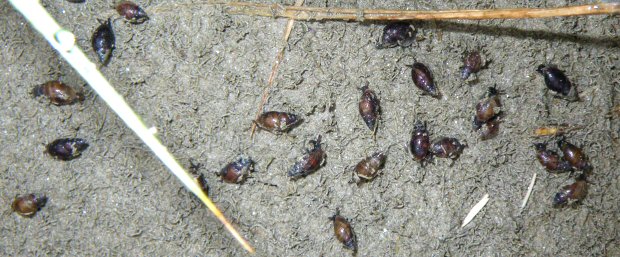
In some places, Myosotella myosotis is
present in large numbers, like here in Britanny. Picture: Florence Gully,
Nature 22: Gastéropodes 2.
![]() Francisco
Welter-Schultes:
Ovatella myosotis species homepage.
Francisco
Welter-Schultes:
Ovatella myosotis species homepage.
![]() Molluscs of Central
Europe:
Mäuseöhrchen (Myosotella myosotis)
(in German).
Molluscs of Central
Europe:
Mäuseöhrchen (Myosotella myosotis)
(in German).
![]() Arbeitskreis Mollusken
NRW:
Weichtier des Jahres 2008 Das Mäuseöhrchen Myosotella myosotis (Draparnaud
1801) (in German).
Arbeitskreis Mollusken
NRW:
Weichtier des Jahres 2008 Das Mäuseöhrchen Myosotella myosotis (Draparnaud
1801) (in German).
Two tooth coast snail - Auriculinella (Leucophytia) bidentata (Montagu 1808)
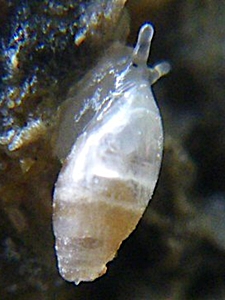 Two-tooth coast snail (Auriculinella bidentata). Picture: Florence Gully (Gastéropodes 2). |
Description: The two toothed coast snail's shell usually has got a horn brown to reddish brown colour. The whorls are only slightly rounded, the apertural whorl making 75% of the shell height. On its upper (parietal, see above) side, the aperture displays a whitish layer (callus). The upper (parietal) lamella is distinctly built, the lower (columellar) lamella, on the other hand, is moderately to indistinctly visible. The shell navel (umbilicus) is invisible.
Contrary to the mouse-ear snail, the two-tooth coast snail does not possess a second parietal lamella.
Dimensions: H: 5 - 7 mm; W: 2 - 4 mm; N: 6 - 7.
Habitat and Distribution: Auriculinella bidentata is an amphibious coastal snail species, which however usually keeps outside of the water. The snails usually live near the tideline, on open coast under stones and in plants washed on the beach. More rarely, the species is found in river mouths and in tide pools. Auriculinella bidentata is more tolerant towards salinity than Myosotella myosotis and mainly feeds on decaying organic material (Detritus).
Auriculinella bidentata lives at the coasts of the Eastern Atlantic (Netherlands, France, British Isles), through the Mediterranean as far east as western Turkey.
![]() Francisco
Welter-Schultes:
Auriculinella bidentata species homepage.
Francisco
Welter-Schultes:
Auriculinella bidentata species homepage.
![]() Molluscs of Central
Europe:
Zweizahn-Küstenschnecke (Auriculinella bidentata) (in German).
Molluscs of Central
Europe:
Zweizahn-Küstenschnecke (Auriculinella bidentata) (in German).